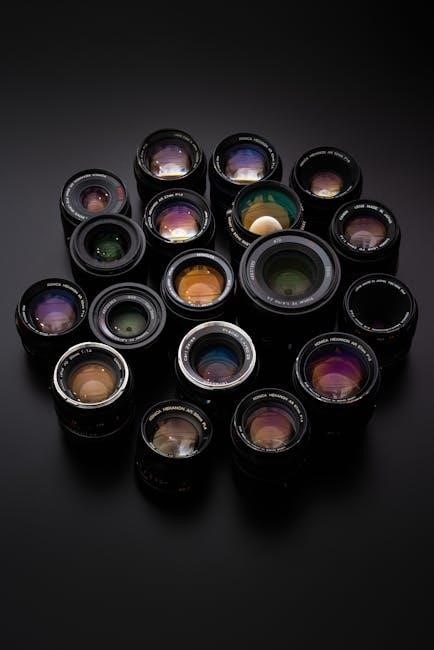The MPC One manual provides a comprehensive guide for music creation and performance using the AKAI MPC One, with detailed instructions and tutorials to help users get started with the device and its various features instantly available.
Overview of the User Guide
The user guide for the MPC One is a detailed manual that covers all aspects of the device, from setting up and getting started to advanced features and techniques. The guide is designed to be easy to follow, with clear instructions and examples to help users understand how to use the MPC One to its full potential. The user guide is available in PDF format and can be downloaded from the official website, making it easily accessible to users. The guide covers topics such as navigating the interface, creating and editing sequences, and using the device’s various effects and processing tools. It also provides information on how to connect the MPC One to other devices, such as computers and audio interfaces, and how to use the device in conjunction with other music production software. Overall, the user guide is an essential resource for anyone looking to get the most out of their MPC One. The guide is comprehensive and well-organized, making it easy for users to find the information they need. The user guide is a valuable tool for music producers and artists.

Downloading the User Guide
The MPC One user guide is available for download as a 77.4 MB PDF file from the official website instantly online now.
Available Files and Formats
The AKAI MPC One user guide is available in various file formats, including PDF, which can be easily downloaded from the official website. The PDF file size is approximately 77.4 MB, making it a comprehensive guide for users. Additionally, the user guide is also available for other MPC products, such as the MPC X, MPC Live, and MPC Touch, in similar file formats. The availability of these files in different formats ensures that users can access the guide on various devices, including computers, tablets, and smartphones. The files can be downloaded instantly, allowing users to start exploring the features and capabilities of the MPC One immediately. The user guide is also available for download in ZIP format, which includes additional resources and files to support the user’s learning experience. Overall, the availability of the user guide in various file formats and sizes makes it easily accessible to users, providing them with a comprehensive resource to learn and master the MPC One. The files are regularly updated to ensure that users have access to the latest information and features.

Hardware Components
The MPC One features various hardware components, including a power switch and USB-B port, allowing for connectivity and functionality instantly with other devices and systems available.
Front Panel Features
The front panel of the MPC One features a variety of controls and connectors, including a SD card slot, allowing users to access and load their own samples and sounds directly into the device. The front panel also features a phones output, which can be used to connect standard 1/8 inch stereo headphones, providing a convenient way to monitor and listen to music and sounds. Additionally, the front panel features 16 drum pads, which can be used to create and perform music, and a built-in LED display, which provides visual feedback and information to the user. The front panel is designed to be intuitive and easy to use, with clearly labeled controls and a logical layout, making it easy for users to navigate and access the various features and functions of the MPC One. The front panel features are designed to provide a comprehensive and flexible music creation and performance system.
Rear Panel Features
The rear panel of the MPC One features a variety of connectors and ports, including a power input, which is used to connect the device to a power source using the included power adapter. The rear panel also features a Link port, which can be used to connect a standard Ethernet cable, allowing the MPC One to be used with Ableton Link and other compatible devices. Additionally, the rear panel features a USB-B port, which can be used to connect the MPC One to a computer, allowing users to transfer files and data between the device and their computer. The rear panel is designed to provide a range of connectivity options, making it easy to integrate the MPC One into a variety of music creation and performance setups. The rear panel features are designed to provide a flexible and convenient way to connect the MPC One to other devices and systems, and to provide a reliable and stable power source for the device. The MPC One rear panel features are an important part of the device’s overall design and functionality.

Specifications of the AKAI MPC One

The AKAI MPC One has various specifications including size, weight, and display details, with a built-in LED display and multiple connectivity options available for use instantly every day.
Product Specifications
The AKAI MPC One product specifications include a range of technical details that define the device’s capabilities and features. The product specifications outline the device’s size, weight, and display details, including a built-in LED display with a diagonal size of 7 inches. The specifications also cover the device’s connectivity options, including USB ports, MIDI interfaces, and other inputs and outputs. Additionally, the product specifications provide information on the device’s performance capabilities, including its processor speed, memory, and storage capacity. The specifications also outline the device’s power requirements and battery life, if applicable. Furthermore, the product specifications may include information on the device’s compatibility with other hardware and software products, as well as its compliance with various industry standards and regulations. Overall, the product specifications provide a comprehensive overview of the AKAI MPC One’s technical capabilities and features, allowing users to understand its potential applications and limitations. The specifications are an essential resource for anyone looking to purchase or use the AKAI MPC One, as they provide a detailed understanding of the device’s capabilities and features.
Technical Details
The AKAI MPC One’s technical details provide a deeper understanding of the device’s internal components and operational capabilities. The device features 16 drum pads, allowing for versatile music creation and performance. The technical details also outline the device’s audio interface capabilities, including its sampling rate and resolution. Additionally, the technical details cover the device’s MIDI implementation, including its compatibility with other MIDI devices and software. The technical details also provide information on the device’s storage capacity, including its internal storage and expandable storage options via SD cards. The device’s technical details are essential for understanding its potential applications and limitations, and for troubleshooting any technical issues that may arise. The technical details are also useful for comparing the AKAI MPC One to other similar devices, and for determining its compatibility with other hardware and software products. Overall, the technical details provide a comprehensive understanding of the AKAI MPC One’s technical capabilities and features. The device’s technical details are an important resource for musicians, producers, and other users who require a deep understanding of the device’s operational capabilities.
